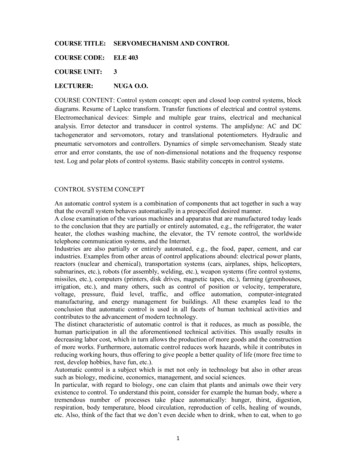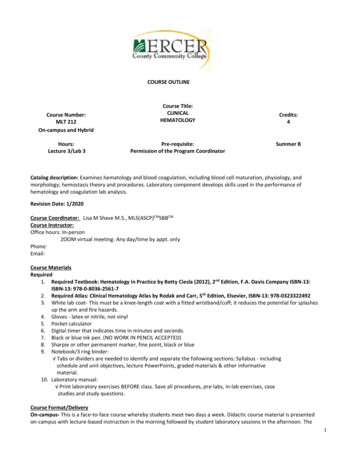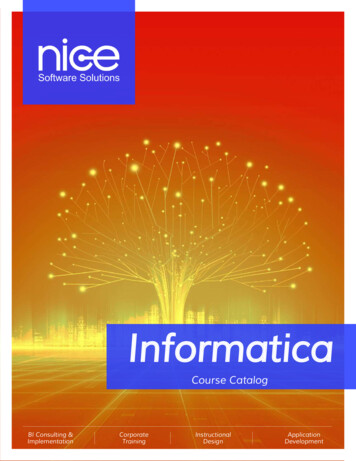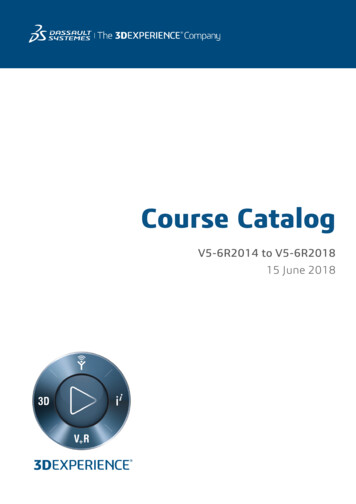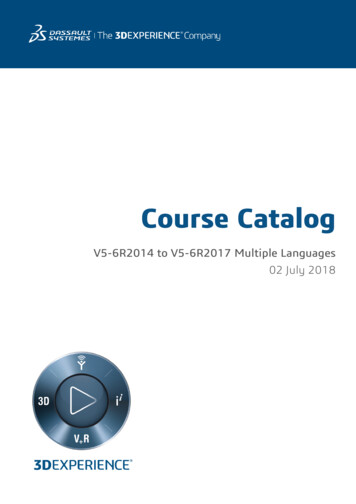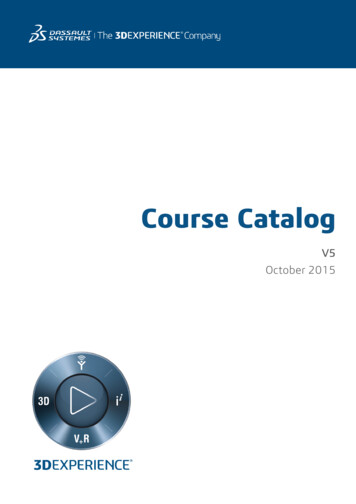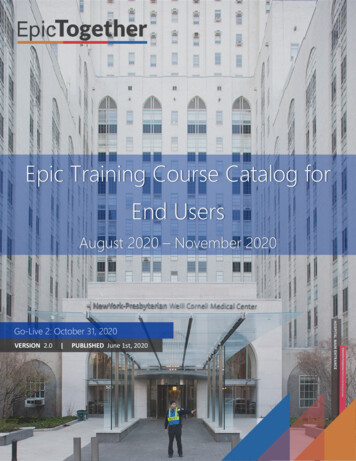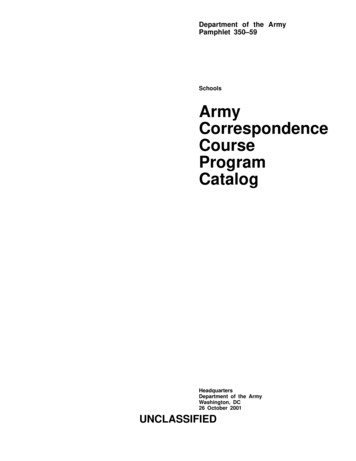
Transcription
eCornell Course CatalogOnline Executive Education from Cornell University
Welcome to eCornellAs Cornell University’s online learning subsidiary, eCornell provides many ofthe world’s leading organizations with online professional development inthe areas of finance, healthcare, hospitality, human resources, leadership,management, and marketing. eCornell’s proven course development modeland asynchronous instructor-led course delivery provide students with aflexible, engaging, and immediately applicable learning experience craftedby Cornell University faculty. eCornell has delivered online courses to over90,000 students in more than 200 countries.The eCornell ExperienceLearning happens through interaction and collaboration —a dynamic,creative process that involves the exchange of ideas, not simply theaccumulation of facts. In eCornell courses you interact with an expertinstructor and a cohort of your peers to collectively develop knowledge,and to effectively apply that knowledge in your organization.eCornell offers a proven delivery model and incorporates the best aspects ofonline and traditional classroom learning, including: Engaging and rigorous course design that centers on authentic businessscenarios and provides the resources and tools learners need to resolvethe issues they pose. Learning experiences that target individual competencies and skills. Asynchronous collaboration activities that contribute to knowledge andexperience sharing among the course learners and the course instructor. Course projects, discussion forums, and job aids that help learners applytheir new skills to real organizational situations. New skill development through interactive assessments and simulations.Program Quality Drives MotivationeCornell courses provide the convenience of structure and flexibility withcourse sessions starting every other week, round-the-clock/round-the-worldaccess to course materials, live online chat, telephone, and email customersupport. This world-class online learning is designed to stimulate and buildmotivation resulting in industry-leading completion rates.Campus ConnectionsCollaboration between Cornell faculty experts and eCornell’s learning anduser- experience designers create unique, engaging, and rigorous learning experiences.eCornell curriculum is developed in partnership with Cornell University’s: College of Engineering College of Human Ecology Johnson School of Management School of Hotel Administration School of Industrial & Labor Relations1
AccreditationeCornell is a registered provider of professional re-certification or continuingeducation units by the following:Cornell UniversityStudents who successfully complete the required courses in a programseries receive a certificate from Cornell University suitable for framing. AlleCornell courses are eligible for continuing education units (CEU), from theSchool of Continuing Education at Cornell University. Courses with theprefix ILR, receive CEUs from the School of Industrial and Labor Relationsat Cornell University.Human Resources Certification Institute (HRCI)eCornell is a Human Resource Certification Institute (HRCI) ApprovedProvider. Many courses are approved toward PHR and SPHR recertificationcredit hours through HRCI.For more information about certification and recertification, pleasevisit the HRCI homepage at www.hrci.org.Project Management Institute (PMI)eCornell is a designated Global Registered Education Provider (R.E.P.)of the Project Management Institute (PMI). As a R.E.P., eCornell hasbeen approved by PMI to issue Professional Development Units (PDUs)to Project Management Professionals (PMPs) seeking to maintain theircertification for many leadership, strategic management, financialmanagement, and management development courses.For more information about PMI visit www.pmi.org.2
eCornell Course Catalog by CategoryFinancial ManagementThese programs, developed by Cornell University faculty, are designed primarily for professionals whoare not financial managers or cost accountants, but who are looking to develop and sharpen their financialacumen. The courses connect the principles of finance, accounting, and economics with the departmentalactivities of the rest of the organization.(HAME507) Mastering the Time Value of MoneyGet an understanding of the time value of money to assess criticaldecisions about investments. Project cash flows, calculate payments, and solve lease-or-buy dilemmas. Know the importance of the timing of future cash flows Understand the various time value of money concepts vital to the field of finance(HAME508) Making Capital Investment DecisionsUse formal frameworks to evaluate the feasibility of new initiatives. Make sound investment decisions thatincrease your organization’s profitability. Learn the rules that provide a framework for making investment decisions Know the right financial decision-making tools to use for research and analysis(HAME509) Risk and Return: How to Identify, Measure, and Incorporate Into Capital Budgeting DecisionsFor the non-financial manager, this answers the important question: how is risk factored into capitalbudgeting decisions? Understand and identify the risks that are relevant to the capital-budgeting decision Analyze and manage the the risk-return relationship into capital-budgeting decisions(HAME510) Raising Capital: The Process, the Players, and Strategic ConsiderationsLearn about the decision frameworks used to create the ideal capital structure. Learn strategies forfundraising and project investment. Find out how capital-structuring decisions at the company levelcan influence project outcomes at the departmental level. Monitor economic data and develop strategies to balance debt and equity at your firm Know how decisions are made regarding corporate restructuring, mergers, acquisitions and bankruptcy(HAME513) Understanding Financial StatementsLearn to read and interpret key financial statements. Conduct financial analyses in order to makeinformed business decisions. Know how to interpret income statements, balance sheets and cash flow statements Identify how online sources of financial information can be used to conduct research on other publiclytraded firms and industries3
(HAME514) Using Ratio Analysis to Evaluate Financial PerformanceUse ratio analysis to inspect financial statements. Understand your organization’s financial performanceand improve its competitiveness. Understand and establish the function of ratios Know the purpose of various asset management ratios, solvency and capital structure ratios, andprofitability ratiosHealthcareGet the essential skills for meeting system design, cost, and patient-centered goals in courses thatcombine research with real-world insights from healthcare administrators and facilities experts. Coursesare developed by faculty members from Cornell’s College of Human Ecology as well as its Sloan Programin Health Administration.(HAME509HC) Risk and Return: How to Identify, Measure, and Incorporate Into Capital BudgetingDecisions (Healthcare Edition)For the non-financial manager, this course serves to answer the important question: how is risk factoredinto capital budgeting decisions? Discuss with your healthcare facility’s finance team in correct meaningful dialogue Understand how the risk-return is incorporated into capital budgeting decisions(SLN551) Transformational Excellence: Change Leadership in HealthcareTo be competitive, reduce risk and meet patients’ needs, hospitals and healthcare organizations musttransform the way they deliver services and manage change. Identifying areas at risk and in need ofimprovement is the first step toward making healthcare organizations operate more efficiently and safely. Describe key areas in need of improvement in the U.S. healthcare system and the specific types ofchanges needed Compare transformational excellence strategies with traditional approaches to change(SLN552) Strategic Planning for Healthcare OrganizationsStrategic planning in healthcare requires a shift in perspective; the service provider must make decisionsand strategize like a modern business person. Learn to evaluate the overall health of the organization andimplement long-term plans for sustainability and success. Develop the right kind of strategies that align with your organization’s core values Analyze data to identify areas in need of improvement(SLN553) Revising and Implementing Your Strategic PlanLearn how to design and implement a strategic plan that best reflects organizational goals. Periodicassessment and revision are usually necessary and generally smart business. Know how internal and external environments affect strategic plans Apply organizational goals and construct a plan for achieving them4
(SLN561) Planning and Designing a Healing EnvironmentHow can you be sure that capital improvement projects in your organization incorporate best practicesand achieve their intended goals? The answer is to look at the evidence: what are the approaches thatother healthcare facilities undertaking similar projects have used that have worked? Ask informed questions as a participant in these projects, leading the team to make better decisions Recommend ways to use scarce resources available for renovation and design projects to the best advantage(SLN562) Basic Tools for Facility PlanningThe process of designing a healthcare facility has a special mission: to have a positive impact on its manyusers—including patients, families, visitors, nurses, physicians, and other clinical and non-clinical staff—while simultaneously fostering cost-effective operations. This course introduces the must-know conceptsand related terminology of healthcare facility planning. Utilize basic, hands-on skills for reading symbols, measuring dimensions, and interpreting plans Make more informed recommendations and provide feedback regarding building and renovation projects(SLN563) Practice Based ResearchWhen a healthcare organization is potentially committing millions of dollars to a capital improvementproject, it’s critical to ensure that the design conforms to best practices and is likely to achieve theintended results. This course lays out a practical approach to conducting small-scale, relatively rapidempirical research studies targeting a specific project, in contrast to relying exclusively on the publishedEBD research literature. Formulate a testable hypothesis that links the design feature to desirable outcomes and benefits Conduct a relatively quick and inexpensive on-site research studyHospitality and Foodservice ManagementThe courses within these certificate programs are developed by professors from Cornell University’sSchool of Hotel Administration, a top-ranked hospitality-management institution. Learn at your paceonline with students from around the globe, build your network, and get the education you need tosucceed from world-wide leaders in your profession.(HAME515) Statistical Decision Making: Describing DataGather, describe, and analyze data on the hospitality industry to extract meaningful business information. Calculate, define, and apply descriptive statistics including median,mean, and standard deviation. Describe and select appropriate methods of gathering data.(HAME516) Statistical Decision Making for Hospitality ManagersPredict future behavior from existing data. Make effective decisions by using statistical tools, identifyingsignificant trends, and analyzing organizational data. Calculate the probability of a given event occurring. Determine if the results of a data analysis are statistically significant.5
(SHA501) Marketing Fundamentals for the Hospitality IndustryLearn fundamental marketing concepts and principles as they relate to hospitality, observe marketing inaction through case studies and understand how to put that knowledge into practice. Understand and speak to marketing techniques for the hospitality industry Be prepared for leadership and success in hospitality marketing(SHA502) Conducting Effective Hospitality Marketing ResearchLearn to conduct effective market research in the hospitality industry, identify target markets, andposition your product for those markets. Develop an understanding of market analysis and strategic positioning Analyze and apply effective market research(SHA503) The Hospitality Marketing Mix: Product and PriceTailor the design and pricing of your hospitality products and services for your target market. Learn how to identify target markets for the right product Explore product life cycles and tailor that product to your business(SHA504) The Hospitality Marketing Mix: Place and PromotionExplore issues related to the location of your hospitality organization, to your products and services andto the distribution channels you use to reach target markets. Learn how to design promotions specific to your demographic market Develop a modern concept of “place” to gain advantages in reaching target markets(SHA505) Meeting the Challenges of Foodservice ManagementThis course identifies major challenges facing foodservice operations and delivers the strategies hospitalityprofessionals need to address them. It explores success and failure, providing critically useful perspectivesfor those intending to plan, open, and manage a foodservice operation. Learn a holistic approach to restaurant management Understand the fundamentals and practical skills for successful operation(SHA506) Foodservice Management: Marketing, Service, and HR SystemsLearn how to enhance the customer experience and improve internal systems at your foodserviceoperation. Examine how market research drives decisions about service style and service level, and learnto overcome customer- and employee-related management challenges. Be able to find the right balance to optimize restaurant efficiency Use research information to improve the overall customer service experience(SHA507) Foodservice Management: Menu Planning and Marketing, and Merchandising StrategiesThis course explores the importance of menu design and layout, and looks at how the menu conveys thepersonality of the foodservice. You’ll also learn how to develop and execute marketing andmerchandising strategies. Develop an appealing menu that aligns with your business’ values and goals Analyze various functions of marketing and merchandising in foodservice6
(SHA508) Foodservice Management: Control Systems and Related SystemsExplore the functions of management in foodservice and discover how managers establish and useoperational systems for purchasing, receiving, storage and production. Explore different management roles to assess control and effectiveness Be able to ensure that your customers enjoy a high-quality dining experience(SHA509) Introduction to Restaurant Revenue ManagementExamine the key concepts of the restaurant revenue management approach and learn how to implementit in five steps. Observe how others have used revenue management successfully to increase revenueduring hot, warm, and cold business periods. Know how to modifying your business to the changing seasons Learn the various steps of the revenue management process(SHA510) Managing Revenue with Service CycleDiscover how to use service cycle data to identify operational problems that are inhibiting revenue generation.Use practical analytical tools to diagnose and overcome operational challenges. Develop the tools to generate revenue and profit more efficiently Know how to analyze data to determine how long it takes customers to eat(SHA511) Managing Revenue with Table MixThis course on restaurant revenue management explains how meal duration and occupancy levels canprofoundly effect the bottom line. It presents concepts, methods, and time-tested strategies managerscan use to increase revenue. Apply strategies to accommodate arrival patterns and manage occupancy and meal duration(SHA512) Managing Revenue with PricingPricing is one of the cornerstones of restaurant revenue management. This course shows you how to usevariable pricing to increase revenue at your restaurant. It prepares you to perform analyses and makecalculations needed for successful revenue management implementation. Provide guidance on how to implement strategies that will be most profitable Use variable-pricing approaches to develop recommendations for improving revenue(SHA531) Introduction to Hotel Revenue ManagementImplement a revenue management strategy that maximizes profits byshifting the focus to managing revenue per available room. Increase revenue by applying special pricingmodels and duration-management techniques. Know the component parts and critical considerations of hotel revenue management Understand different ways in which revenue management can be applied to otherhospitality-related industries7
(SHA532) Forecasting and Availability Controls in Hotel Revenue ManagementUse forecasts to predict demand and learn how demand influences other organizational functions. Calculateand account for error and apply length-of-stay controls. Learn the role of forecasting hotel revenue management Recommend room rates and length-of-stay controls to your hotel(SHA533) Pricing Strategy and Distribution Channels in HotelRevenue ManagementSet prices that align with your organization’s sales and positioning strategies. Usethe appropriate distribution channels to manage prices. Understand the impact of variable pricing and discounting on revenue management Recommend different approaches to making prices more variable(SHA534) Overbooking Practices in Hotel Revenue ManagementOverbook strategically to account for no-shows and minimize costs, uncertainty, and customer impact.Examine visiting groups’ costs and revenues to identify profitable targets. Develop your own overbooking approach and manage the issues associated with it Know how to apply group-management decisions(SHA535) Non-Traditional Applications of Hotel Revenue ManagementDevelop, implement, and monitor revenue-maximizing strategies in hospitality-related industries. Maximizetop-line revenue in spas, golf courses, and meeting spaces. Develop your own successful functional revenue management plan Extend your own practice of revenue management to other industries(SHA541) Price and Inventory ControlsLay the groundwork for demand management as you learn the role of marginal value of capacity inrevenue growth and overall revenue management strategy. Evaluate the effects of price, length of stay, demand, and availability controls on revenue Analyze the effects of multiple resource controls— rate and length of stay controls(SHA542) Price Sensitivity and Pricing DecisionsPricing strategy is the central component in your overall profit performance. This online course preparesyou to anticipate the impact certain pricing decisions will have on consumer demand and thrive in a highlycompetitive environment. Estimate price sensitivity and use the results in pricing decisions Use mathematical modeling and analysis to understand the relation ship between variable(SHA543) Segmentation and Price OptimizationLead team meetings that result in increased productivity. Structure personal time, workload, and prioritiesto maintain a positive work-life balance. Apply variable versus dynamic pricing strategies Use prospect theory to structure pricing communication8
(SHA544) Displacement and Negotiated PricingGroup events, conferences and negotiated business bookings frequently account for over 50% of hotelroom reservations. This course will prepare you to develop your own data-driven, systematic approachto group pricing. Distinguish between transient revenue management and negotiated selling Calculate the implications of market mix(SHA545) Search Engines and Online Selling: Stimulating Incremental DemandLearn how to optimize your position on Internet search results and increase conversions: the momentwhen a search beco
Hospitality and Foodservice Management The courses within these certificate programs are developed by professors from Cornell University’s School of Hotel Administration, a top-ranked hospitality-management institution. Learn at your pace online with students from around the glo


